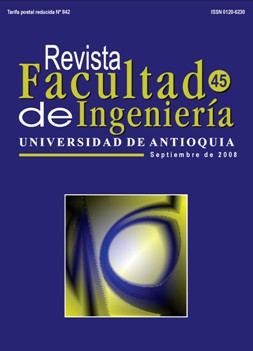A Novel Routing Algorithm for Vehicular Ad Hoc Networks
DOI:
https://doi.org/10.17533/udea.redin.18119Keywords:
vehicular ad hoc networks, mobile ad hoc networks, wireless ad hoc networksAbstract
This article examines the importance of wireless ad hoc networks and the Location Routing Algorithm with Cluster-Based Flooding (LORA-CBF) for inter-vehicular communication in the context of optimizing traffic flow and increasing motorway safety. The LORA-CBF routing algorithm is discussed and simulated in detail, considering a motorway environment with its associated high mobility. First, for small-scale networks, our proposed simulation model is validated with the results of a test bed. Then, for large-scale networks we use simulations to compare our model with both the Ad Hoc On-Demand Distance Vector (AODV) and Dynamic Source Routing (DSR) algorithms. We use a microscopic traffic model, developed in OPNET, to ascertain the mobility of 250 vehicles on a motorway. Finally, we apply LORA-CBF in a vehicular test bed.
Downloads
References
R. A. Santos, A. Edwards, R. M. Edwards, N. L. Seed. “performance evaluation of routing protocols in vehicular ad-hoc networks”. International Journal Ad Hoc and Ubiquitous Computing. Vol. 1. 2005. pp. 80-91. DOI: https://doi.org/10.1504/IJAHUC.2005.008022
M. M. Minderhoud. Simone 2000, simulation model of motorways with next generation vehicles, technical specification. 2002. pp. 1-58.
C. H. Rokitansky, C. Wietfeld. “Comparison of Adaptive Medium Access Control Schemes for Beacon-Vehicle Communications”. IEEE-IEE Vehicle Navigation & Information Systems Conference. 1993. pp. 295-299.
G. Brasche, C. H. Rokitansky, C. Wietfeld. “Communication Architecture and Performance Analysis of Protocols for RTT Infrastructure Networks and Vehicle-Roadside Communications”. IEEE 44th Vehicular Technology Conference. 1994. pp. 384-390.
H. Füßler, M. Mauve, H. Hartenstein, M. Käsemann, D. Vollmer. “MobiCom Poster: Location-Based Routing for Vehicular Ad- Hoc Networks”. ACM SIGMOBILE Mobile Computing and Communication Review. Vol. 7. 2003. pp. 47-49. DOI: https://doi.org/10.1145/881978.881992
C. Lochert, H. Füßler, H. Hartenstein, D. Hermann, J. Tian, M. Mauve. “A Routing Strategy for Vehicular Ad-hoc Networks in City Environments”. IEEE Intelligent Vehicles Simposium. 2003. pp. 156-161.
S. P. Hoogendoorn, H. L. Bovy. “State-of-the-art of Vehicular Traffic Flow Modelling”. Special Issue on Road Traffic Modelling and Control of the Journal of System and Control Engineering. Vol. 215. 2001. pp. 283-303. DOI: https://doi.org/10.1243/0959651011541120
D. C. Festa, G. Longo, G. Mazzulla, G. Musolino. “Experimental analysis of different simulation models for motorway traffic flow”. Proceedings of the IEEE Intelligent Transportation Systems Conference. 2001. pp. 675- 680.
B. Cvetkovski, L. Gavrilovska. “A simulation of a mobile Highway traffic”. IEEE VTC. 1998. pp. 1429-1433.
J. Broch, D. Maltz, D. Johnson, Y.-C. Hu, J. Jetcheva. “A performance comparison of multi-hop wireless ad hoc networks routing protocols”. Proceedings of the 4th ACM/IEEE International Conference on Mobile Computing and Networking (MOBICOM). Dallas, USA. 1998. pp. 85-97. DOI: https://doi.org/10.1145/288235.288256
C. K., Toh, D. Minar, and A. Donald. “Evaluating the communication performance of an ad-hoc wireless network”. IEEE Transaction on Wireless Communication. Vol. 1. 2002. pp. 402-414. DOI: https://doi.org/10.1109/TWC.2002.800539
Downloads
Published
How to Cite
Issue
Section
License
Revista Facultad de Ingeniería, Universidad de Antioquia is licensed under the Creative Commons Attribution BY-NC-SA 4.0 license. https://creativecommons.org/licenses/by-nc-sa/4.0/deed.en
You are free to:
Share — copy and redistribute the material in any medium or format
Adapt — remix, transform, and build upon the material
Under the following terms:
Attribution — You must give appropriate credit, provide a link to the license, and indicate if changes were made. You may do so in any reasonable manner, but not in any way that suggests the licensor endorses you or your use.
NonCommercial — You may not use the material for commercial purposes.
ShareAlike — If you remix, transform, or build upon the material, you must distribute your contributions under the same license as the original.
The material published in the journal can be distributed, copied and exhibited by third parties if the respective credits are given to the journal. No commercial benefit can be obtained and derivative works must be under the same license terms as the original work.










 Twitter
Twitter